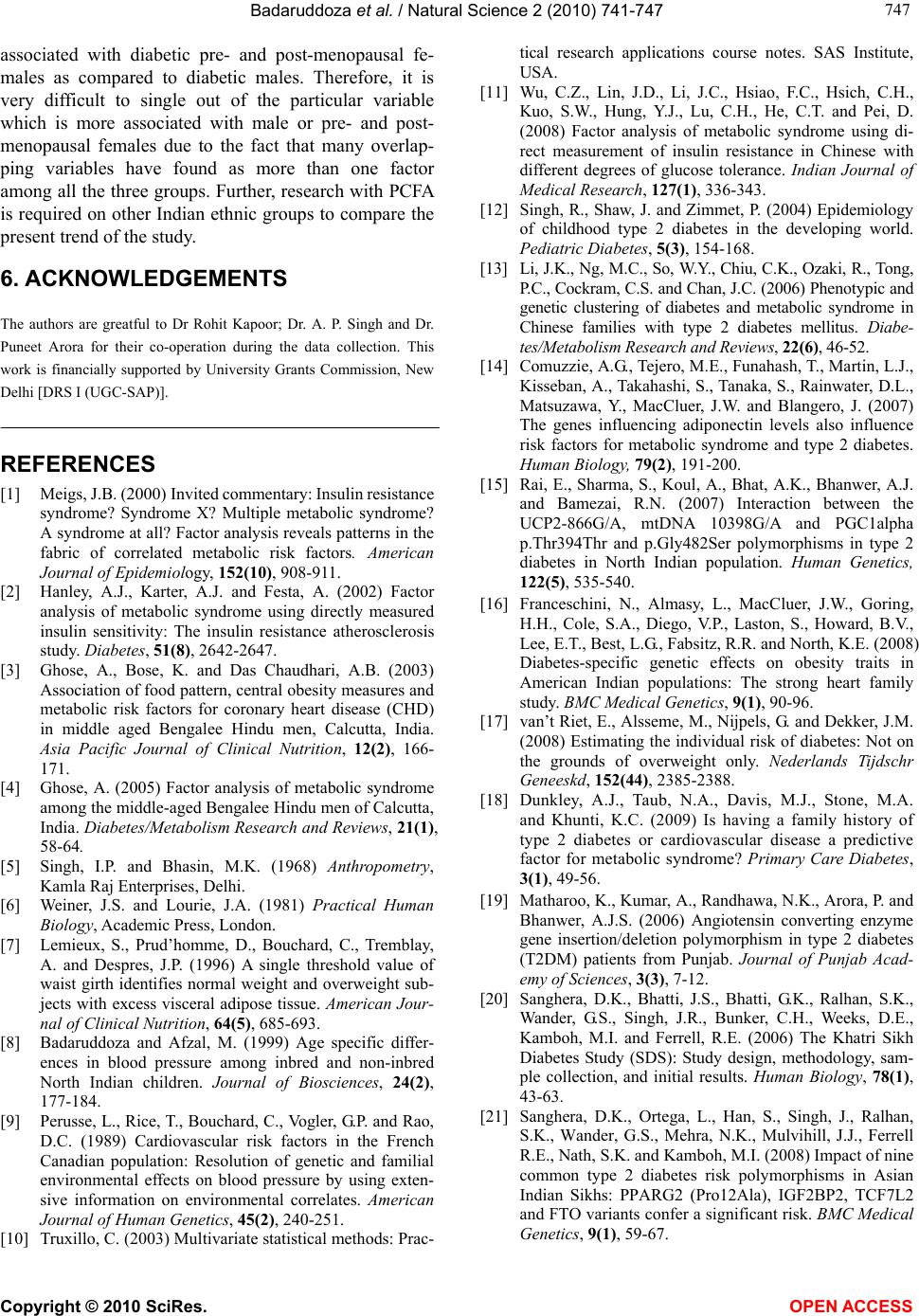
Badaruddoza et al. / Natural Science 2 (2010) 741-747
Copyright © 2010 SciRes. OPEN ACCESS
747
747
associated with diabetic pre- and post-menopausal fe-
males as compared to diabetic males. Therefore, it is
very difficult to single out of the particular variable
which is more associated with male or pre- and post-
menopausal females due to the fact that many overlap-
ping variables have found as more than one factor
among all the three groups. Further, research with PCFA
is required on other Indian ethnic groups to compare the
present trend of the study.
6. ACKNOWLEDGEMENTS
The authors are greatful to Dr Rohit Kapoor; Dr. A. P. Singh and Dr.
Puneet Arora for their co-operation during the data collection. This
work is financially supported by University Grants Commission, New
Delhi [DRS I (UGC-SAP)].
REFERENCES
[1] Meigs, J.B. (2000) Invited commentary: Insulin resistance
syndrome? Syndrome X? Multiple metabolic syndrome?
A syndrome at all? Factor analysis reveals patterns in the
fabric of correlated metabolic risk factors. American
Journal of Epidemiology, 152(10), 908-911.
[2] Hanley, A.J., Karter, A.J. and Festa, A. (2002) Factor
analysis of metabolic syndrome using directly measured
insulin sensitivity: The insulin resistance atherosclerosis
study. Diabetes, 51(8), 2642-2647.
[3] Ghose, A., Bose, K. and Das Chaudhari, A.B. (2003)
Association of food pattern, central obesity measures and
metabolic risk factors for coronary heart disease (CHD)
in middle aged Bengalee Hindu men, Calcutta, India.
Asia Pacific Journal of Clinical Nutrition, 12(2), 166-
171.
[4] Ghose, A. (2005) Factor analysis of metabolic syndrome
among the middle-aged Bengalee Hindu men of Calcutta,
India. Diabetes/Metabolism Research and Reviews, 21(1),
58-64.
[5] Singh, I.P. and Bhasin, M.K. (1968) Anthropometry,
Kamla Raj Enterprises, Delhi.
[6] Weiner, J.S. and Lourie, J.A. (1981) Practical Human
Biology, Academic Press, London.
[7] Lemieux, S., Prud’homme, D., Bouchard, C., Tremblay,
A. and Despres, J.P. (1996) A single threshold value of
waist girth identifies normal weight and overweight sub-
jects with excess visceral adipose tissue. American Jour-
nal of Clinical Nutrition, 64(5), 685-693.
[8] Badaruddoza and Afzal, M. (1999) Age specific differ-
ences in blood pressure among inbred and non-inbred
North Indian children. Journal of Biosciences, 24(2),
177-184.
[9] Perusse, L., Rice, T., Bouchard, C., Vogler, G.P. and Rao,
D.C. (1989) Cardiovascular risk factors in the French
Canadian population: Resolution of genetic and familial
environmental effects on blood pressure by using exten-
sive information on environmental correlates. American
Journal of Human Genetics, 45(2), 240-251.
[10] Truxillo, C. (2003) Multivariate statistical methods: Prac-
tical research applications course notes. SAS Institute,
USA.
[11] Wu, C.Z., Lin, J.D., Li, J.C., Hsiao, F.C., Hsich, C.H.,
Kuo, S.W., Hung, Y.J., Lu, C.H., He, C.T. and Pei, D.
(2008) Factor analysis of metabolic syndrome using di-
rect measurement of insulin resistance in Chinese with
different degrees of glucose tolerance. Indian Journal of
Medical Research, 127(1), 336-343.
[12] Singh, R., Shaw, J. and Zimmet, P. (2004) Epidemiology
of childhood type 2 diabetes in the developing world.
Pediatric Diabetes, 5(3), 154-168.
[13] Li, J.K., Ng, M.C., So, W.Y., Chiu, C.K., Ozaki, R., Tong,
P.C., Cockram, C.S. and Chan, J.C. (2006) Phenotypic and
genetic clustering of diabetes and metabolic syndrome in
Chinese families with type 2 diabetes mellitus. Diabe-
tes/Metabolism Research and Reviews, 22(6), 46-52.
[14] Comuzzie, A.G., Tejero, M.E., Funahash, T., Martin, L.J.,
Kisseban, A., Takahashi, S., Tanaka, S., Rainwater, D.L.,
Matsuzawa, Y., MacCluer, J.W. and Blangero, J. (2007)
The genes influencing adiponectin levels also influence
risk factors for metabolic syndrome and type 2 diabetes.
Human Biology, 79(2), 191-200.
[15] Rai, E., Sharma, S., Koul, A., Bhat, A.K., Bhanwer, A.J.
and Bamezai, R.N. (2007) Interaction between the
UCP2-866G/A, mtDNA 10398G/A and PGC1alpha
p.Thr394Thr and p.Gly482Ser polymorphisms in type 2
diabetes in North Indian population. Human Genetics,
122(5), 535-540.
[16] Franceschini, N., Almasy, L., MacCluer, J.W., Goring,
H.H., Cole, S.A., Diego, V.P., Laston, S., Howard, B.V.,
Lee, E.T., Best, L.G., Fabsitz, R.R. and North, K.E. (2008)
Diabetes-specific genetic effects on obesity traits in
American Indian populations: The strong heart family
study. BMC Medical Genetics, 9(1), 90-96.
[17] van’t Riet, E., Alsseme, M., Nijpels, G. and Dekker, J.M.
(2008) Estimating the individual risk of diabetes: Not on
the grounds of overweight only. Nederlands Tijdschr
Geneeskd, 152(44), 2385-2388.
[18] Dunkley, A.J., Taub, N.A., Davis, M.J., Stone, M.A.
and Khunti, K.C. (2009) Is having a family history of
type 2 diabetes or cardiovascular disease a predictive
factor for metabolic syndrome? Primary Care Diabetes,
3(1), 49-56.
[19] Matharoo, K., Kumar, A., Randhawa, N.K., Arora, P. and
Bhanwer, A.J.S. (2006) Angiotensin converting enzyme
gene insertion/deletion polymorphism in type 2 diabetes
(T2DM) patients from Punjab. Journal of Punjab Acad-
emy of Sciences, 3(3), 7-12.
[20] Sanghera, D.K., Bhatti, J.S., Bhatti, G.K., Ralhan, S.K.,
Wander, G.S., Singh, J.R., Bunker, C.H., Weeks, D.E.,
Kamboh, M.I. and Ferrell, R.E. (2006) The Khatri Sikh
Diabetes Study (SDS): Study design, methodology, sam-
ple collection, and initial results. Human Biology, 78(1),
43-63.
[21] Sanghera, D.K., Ortega, L., Han, S., Singh, J., Ralhan,
S.K., Wander, G.S., Mehra, N.K., Mulvihill, J.J., Ferrell
R.E., Nath, S.K. and Kamboh, M.I. (2008) Impact of nine
common type 2 diabetes risk polymorphisms in Asian
Indian Sikhs: PPARG2 (Pro12Ala), IGF2BP2, TCF7L2
and FTO variants confer a significant risk. BMC Medical
Genetics, 9(1), 59-67.